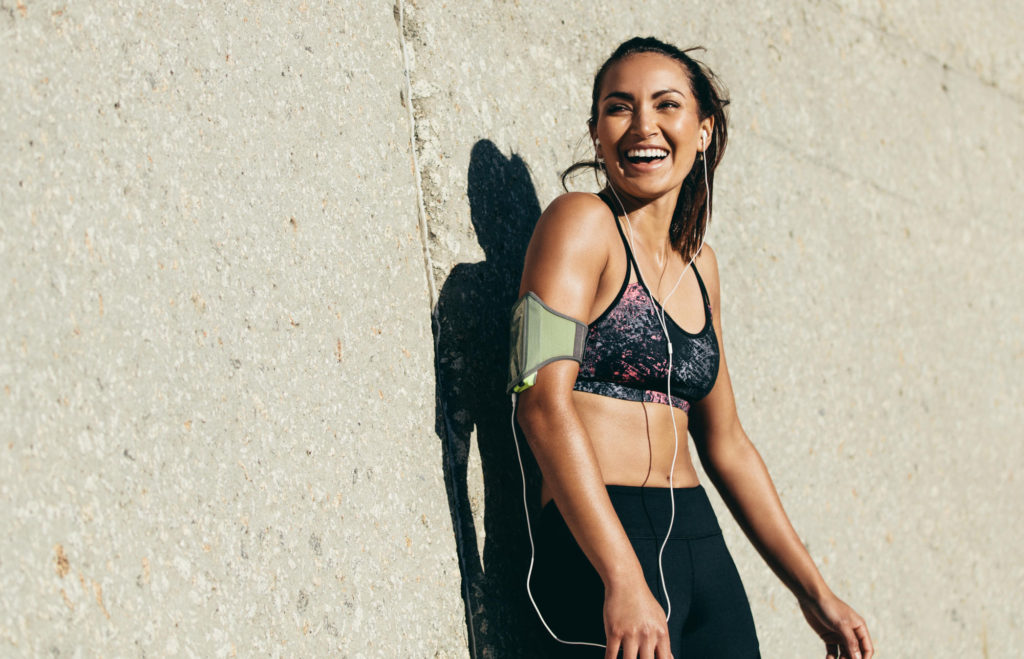
Ever get bored with your workout? I do. A lot. A LOT a lot. Which is why this full-body bodyweight workout uses combination exercises to keep your body and mind engaged the whole time.
There are tons of ways to keep your workouts interesting, and I highly suggest you do, given that engagement should be your number one goal for choosing a fitness regimen. If you don’t love it on some level, then you’ll make excuses to skip your workouts or do the bare minimum.
Combine and conquer with combination exercises.
Combining exercises stimulates your brain and body differently, allowing you to sink into a longer exercise rhythm while also exercising agility as you move from one to the next. It also provides a rest period for each exercise and muscle group so you have a natural balance and flow, possibly leading to a higher volume of repetitions overall.
These movements also make it easy to slip into a meditative exercise state, which is why some combination exercises have weird names, like “Snow Whites.” I was in some dream-like trance while doing that exercise one day by the ocean. I mean, why not, right?
This workout is 100% bodyweight, meaning you need zero equipment. Oh, wait. No, you do need one thing: a step or chair. But no pull-up bar, balance ball, weights or anything else is needed.
But don’t let that fool you. This workout is quite challenging for the upper and lower body.
Instructions.
Part 1.
3 rounds
- 6 Snow Whites L (2 Bulgarian jump squats and 2 one-legged squats)
- 10 triple jump lunge (2 static and 1 regular)
- 6 Snow Whites R
- 10 triple side jump lunge and jump up
- 6 elevated double push-up to double shoulder press
- 20 downward-facing twisted chair dips
Part 2.
10 min AMRAP
- 14 twist jumps
- 5 jump tucks (one after another)
- 10 diagonal push-up jumps
- 5 jump tucks (one after another)
- 4 Jump lunge broad jump burpees
Snow Whites (2 Bulgarian jump squats and 2 one-legged squats).

Combination exercise: 2 bulgarian squats and 2 one-legged squats. The movement should flow pretty smoothly: jump, jump, move leg, squat, squat, move leg back.
Bulgarian squats.
Get a chair, or even better, a low block or step. I find the ideal height is less than the usual 24-ish inches high a chair is, but that will work fine. Stand on one leg in front of the chair/block/step, upon which the top of your other foot is resting. While doing this move, always be sure to push through your heel, feel your butt muscles, and never have your knee go beyond your toes.
Bend your standing leg until your thigh is parallel or almost parallel to the floor, then spring up in a jump from this position and come back down, then spring back up again. This is 2 continuous reps. Move your back foot off the chair/block/step and in front of you, moving into the one-legged squats.
One-legged squats (pistol squats).
On one leg, with the other out in front, lower yourself by bending at the hips and pushing your hips backward. Never bend at the knees first. Your knees should not go past your toes at this point, and most of your weight should be pushing through your heel. This move does require balance, so occasionally you will feel your weight shift forward. Just naturally adjust back through your heel as you regain balance. Continue down in a controlled manner—don’t let go and drop all the way down, at least not at this point. You should feel this working your glutes as you get to the point where your thigh is parallel with the ground. After a brief pause, reverse the movement back up and repeat again.
This is one rep of the Snow White.
Modifications.
Advanced: If you can (or want to), lower yourself all the way down on the one-legged squat. Your knee will go beyond your toes at this point—that’s okay. Stay in control as much as you can before dropping down to the bottom position. Reverse back to standing.
Beginner: Don’t jump on the Bulgarians. Just lower yourself down to parallel and come back up. For the one-legged squat, there are loads of modifications on this post, but I suggest the one-legged box squat. Sit down, back straight. Go up to standing on one leg from here, holding your arms out straight in front for balance. Your other leg should naturally be held a little in front. From standing, sit back down on the chair from the one-legged position.
Triple jump lunge.
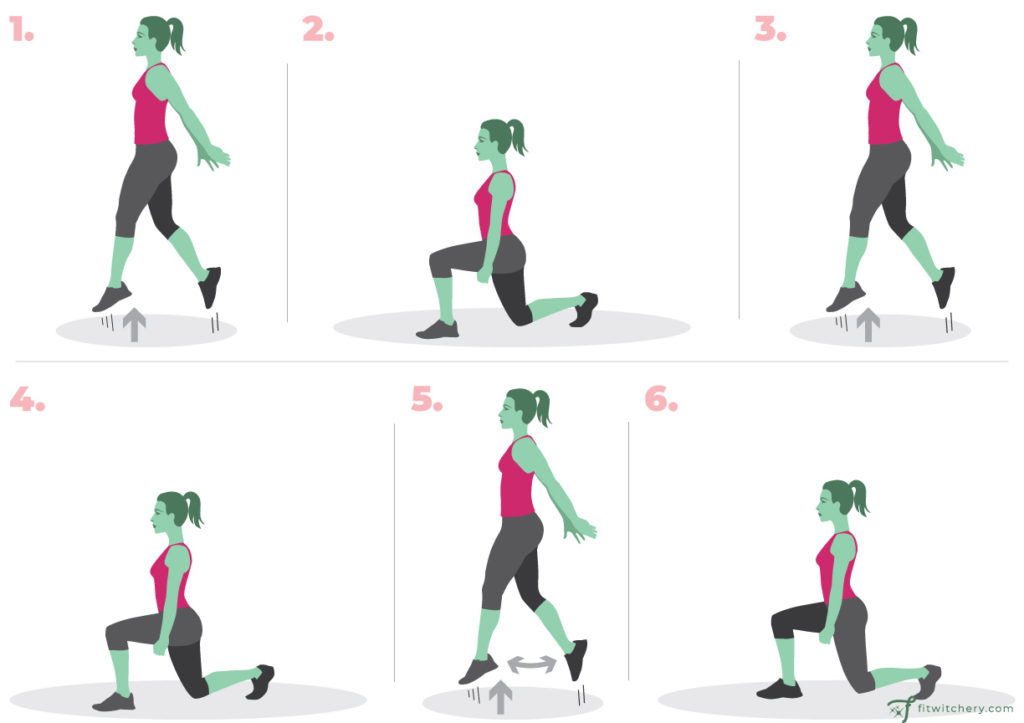
Combination exercise: 2 static jump lunges and one regular jump lunge (switching).
Static jump lunges.
Start in a lunge position, with your knee at a 90-degree angle and your body upright and aligned over your hips. Jump up, propelling from the front leg, making sure to push through the heel and engaging your butt. Come back down into the lunge position, then jump up again, and come back down again. That’s 2 static jump lunges.
Jump lunge.
On the third jump up, switch legs in the air and come down in a lunge on the opposite leg. This is one full rep of the combo. You now start the second rep immediately on this leg.
Modifications:
Beginner: Do two back lunges instead of the static jump lunges, and then do the jump lunge regular. Or, if you cannot do the jump lunge, do 3 back lunges for one rep.
10 triple side jump lunge and jump up.

Combination exercise: 3 side jump lunges and a jump up. This moves pretty fast. Starting on the left leg, it goes jump – R lunge – jump – L lunge – jump – R lunge – jump up on R leg. Then: jump – L lunge, etc.
Side jump lunges.
Do a side lunge by bending down on one leg, hinging at the hips and sticking your butt back, and extending your other leg to the side. Jump up, switch legs and come down into a side lunge on the other side. Jump up again and come down for the third time.
Jump up.
Jump up again but don’t switch legs. From that side lunge, just jump up on the standing leg and return to the side lunge and go right into the next rep, which will have the jump up on the opposite leg.
Modifications.
Beginner: Beginners might be able to do this as-is. If not, try doing just the side jump lunges and then a standing knee-up instead of the jump up. Or, you could skip the jump and do 3 bodyweight side lunges and knee up. However, if your knees are bothered by the side lunges, do back lunges instead.
Elevated double push-up to double shoulder press.
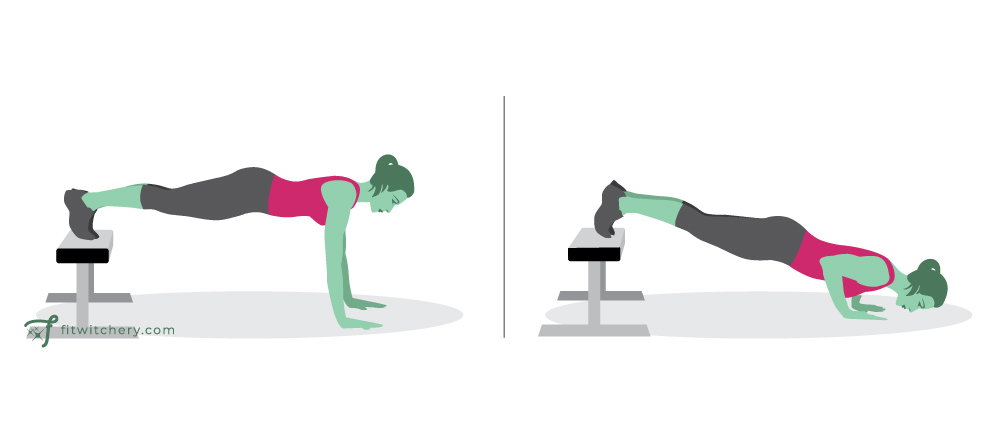
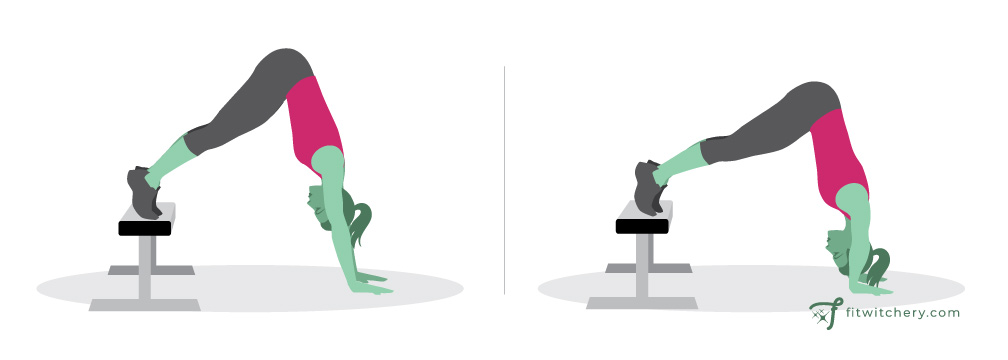
Combination exercise: 2 elevated push-ups and 2 elevated shoulder presses (pike presses). Walk your hands from one to another.
Elevated push-ups.
This is a push-up with your feet elevated on a step or chair. This places more of your weight on your hands, so the higher the elevation, the harder it is. Get in a plank position, but with your legs on an elevated surface and your hands on the floor, shoulder-width apart. Keeping your entire body still taut and in a straight line, bend your elbows as you lower your chest close to the ground. Come as close as possible, about when the tip of your nose hits the ground, or as close as you are able. Push back up to starting position, still keeping that straight form. Repeat for 2 reps.
Walk your hands in to do the shoulder presses.
Elevated shoulder presses.
Get into a downward dog position, with your butt in the air and your hands on the ground, arms straight. Put your feet up on an elevated surface. Lower your head to the ground by bending your arms, then straighten to lift yourself back up. You should feel this in the shoulders. Repeat for a second rep.
Walk your hands back out for the push-ups to begin the next rep.
Modifications.
Beginner: Don’t elevate. Just keep your feet on the floor. If you aren’t able to do a push-up or shoulder press, do both from your knees. For the shoulder press, you’d technically do a box push-up, where your hips are at a right angle.
Downward-facing twisted chair dips.
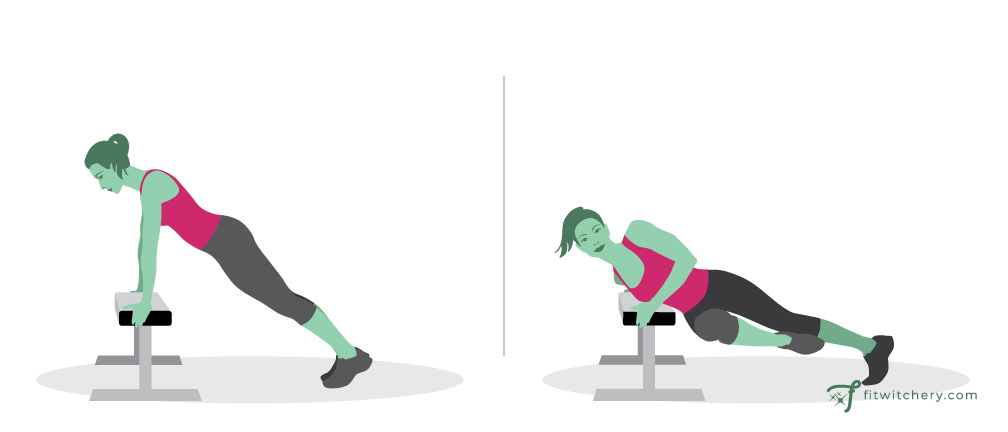
No combination exercises this time! This is really similar to an arm-elevated push-up but slightly different. Get a chair or step, but it should be at least chair height (24 inches or so) and have an edge you can grab by the sides.
Position yourself with your feet on the ground and your hands grabbing the side edges of the chair. Your arms should be straight, your shoulders directly above your hands and your body should be in a straight diagonal line. Lower your chest to the chair by bending your elbows. At the same time, twist to one side, bending the opposite knee and pointing it in the same direction you’re looking. Twist back to the starting position. Next rep, twist the opposite direction.
This is very similar to an arm-elevated push-up but slightly different. A dip is usually vertical, and you lower yourself down and push back up. This is a modification of a normally vertical exercise, and you should feel this mostly in your triceps, and not much in your chest, like you would a push-up. Also, your hands will fall slightly lower on your body than they would on a push-up.
Modifications.
Beginner: Play with the height of the chair, and just lower yourself as much as you are able.
Twist jumps.
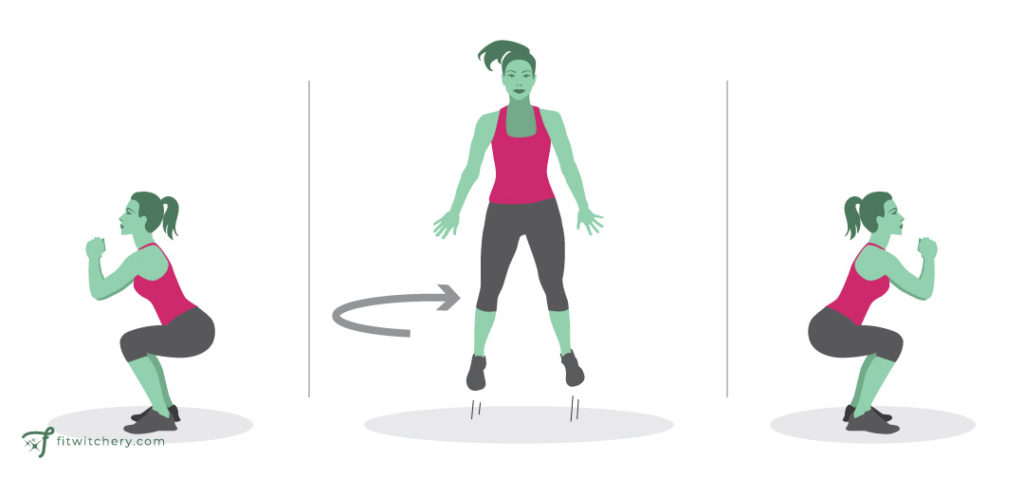
Jump squat and turn 180 degrees in the air. Turn back the opposite direction.
Modifications:
Jump squat with no twist or bodyweight squats.
Jump tuck (continuous).
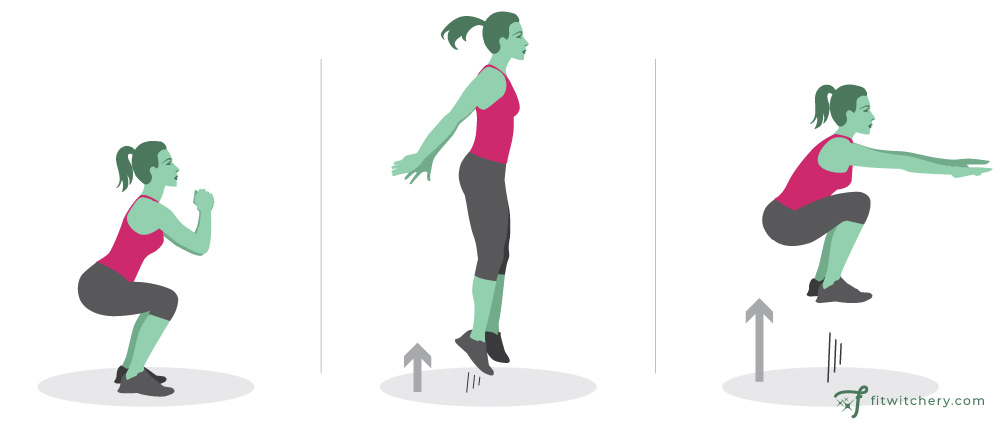
Bend down into a squat and jump up in the air, bringing your knees up in the air. You can put your hands out as markers for them to hit.
Modifications.
Do jump squats instead.
Diagonal push-up jumps.
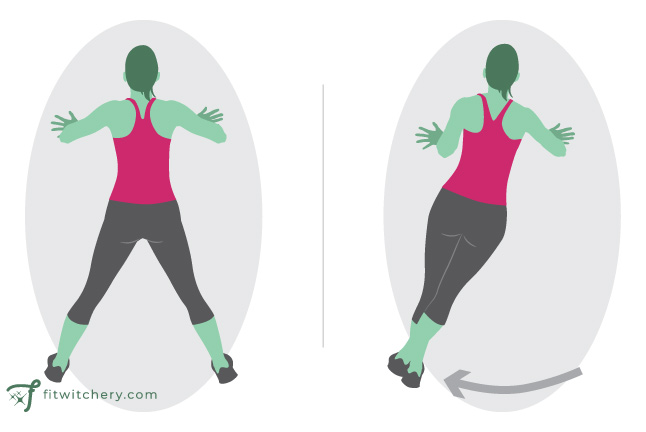
In push-up position, put your hands a little wider than shoulder width, with your fingers pointing outwards. This puts a little more emphasis on the biceps. Then put your legs wide as well. Lift one leg and place on top of the other, so your body is on a diagonal rather than straight up and down in relation to your hands. Do a push-up in this position. Jump to the other side, to the other foot and do a push-up on the other side. Alternate each side like this, jumping from one foot to the other.
Modifications.
Don’t jump. Just step your feet to the other side. You can also place your hands outward, if possible, on an elevated surface. If it’s a chair, you can easily grab the seat with your hands in this position. Continue the rest of the movement like so. If this is too difficult, try a more elevated surface, or even a wall.
Jump lunge broad jump burpees.



Combination exercise: 4 jump lunges, broad jump, burpee with push up, twist jump. It’s just a looooong burpee.
Jump lunges.
Start in a lunge position, with your knee at a 90-degree angle and your body upright and aligned over your hips. Jump up, propelling from the front leg, making sure to push through the heel and engaging your butt. Switch legs in the air and come down in a lunge on the opposite leg. Do this for 4 reps.
Broad jump.
From a squat position, do a jump squat forward as far as you can (or are able), landing in a squat on the other end. Come up. If you’re using a mat, going from one end to the other is a good way to measure.
Burpee (with push-up).
From a squat, place your hands on the ground and jump your feet back so you’re in a push-up plank position. Do a push-up. Jump your feet up towards your hands (what I call “burpee-ing up”) and stand up.
Twist jump.
See above! Just do a jump squat and turn 180 degrees.
Now you start over from the beginning, going the opposite direction.
Modifications.
Do regular back lunges instead of jumps. Skip the push-up if it’s too difficult. Keep the broad jump and twist jump small.
Record your times.
This took me 26:28 for part 1, and in part 2 I got in 3 rounds plus 10 twist jumps.
What did you get? Keep track in your workout journal so you can compare for the next time you do the workout.

